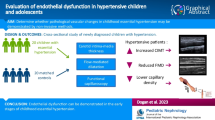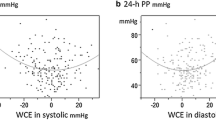Abstract
Several studies have demonstrated endothelial dysfunction in patients with essential hypertension. However, the presence of endothelial dysfunction in children with white-coat hypertension has not been studied. We evaluated the endothelial function in children with white-coat hypertension and essential hypertension using a novel method based on the assessment of flow-mediated dilation (FMD). Study involved 106 children: 30 white-coat hypertensives (age 16.3 ± 1.3 years, mean ± SD), 30 essential hypertensives (age 16.4 ± 1.3 years), and 46 healthy controls (age 16.2 ± 1.4 years). Ultrasound scans of the right brachial artery were performed using Prosound F75 Aloka system during protocol: baseline (1 min), forearm ischemia (5 min), and post-occlusion phase (3 min). FMD (%) was expressed as a change of the arterial diameter from baseline to maximum post-occlusion value and the values < 5% were considered as deficient FMD. We found significantly lower FMD in both essential and white-coat hypertension compared to control group (p < 0.05 for both) with no significant difference between the hypertensive groups. Deficient FMD was found in both hypertensive groups, but not in the control group. The occurence of deficient FMD was significantly higher in both essential and white-coat hypertensives compared to controls (p < 0.01 for both) with no significant difference between the hypertensive groups. Our findings of endothelial dysfunction indicated by impaired FMD in pediatric patients with white-coat hypertension could help to elucidate the mechanisms of the increased cardiovascular risk that could be similar as found in essential hypertension; therefore, white-coat hypertension should not be considered a benign phenomenon.

Similar content being viewed by others
References
Bucher BS, Ferrarini A, Weber N, Bullo M, Bianchetti MG, Simonetti GD (2013) Primary hypertension in childhood. Curr Hypertens Rep 15:444–452
National High Blood Pressure Education Program Working Group on High Blood Pressure in Children and Adolescents (2004) The fourth report on the diagnosis, evaluation and treatment of high blood pressure in children and adolescents. Pediatrics 114:555–576
Falkner B (2010) Hypertension in children and adolescents: epidemiology and natural history. Pediatr Nephrol 25:1219–1224
McNiece KL, Poffenbarger TS, Turner JL, Franco KD, Sorof JM, Portman RJ (2007) Prevalence of hypertension and pre-hypertension among adolescents. J Pediatr 150:640–644
Din-Dzietham R, Liu Y, Bielo MV, Shamsa F (2007) High blood pressure trends in children and adolescents in national surveys, 1963 to 2002. Circulation 116:1488–1496
Landray MJ, Lip GY (1999) White coat hypertension: a recognised syndrome with uncertain implications. J Hum Hypertens 13:5–8
Matsuoka S, Kawamura K, Honda M, Awazu M (2002) White coat effect and white coat hypertension in pediatric patients. Pediatr Nephrol 17:950–953
Stabouli S, Kotsis V, Toumanidis S, Papamichael C, Constantopoulos A, Zakopoulos N (2005) White-coat and masked hypertension in children: association with target-organ damage. Pediatr Nephrol 20:1151–1155
Gustavsen PH, Høegholm A, Bang LE, Kristensen KS (2003) White coat hypertension is a cardiovascular risk factor: a 10-year follow-up study. J Hum Hypertens 17:811–817
Corretti MC, Anderson TJ, Benjamin EJ, Celermajer D, Charbonneau F, Creager MA, Deanfield J, Drexler H, Gerhard-Herman M, Herrington D, Vallance P, Vita J, Vogel R, International Brachial Artery Reactivity Task Force (2002) Guidelines for the ultrasound assessment of endothelial-dependent flow-mediated vasodilation of the brachial artery: a report of the International Brachial Artery Reactivity Task Force. J Am Coll Cardiol 39:257–265
Thijssen DH, Black MA, Pyke KE, Padilla J, Atkinson G, Harris RA, Parker B, Widlansky ME, Tschakovsky ME, Green DJ (2011) Assessment of flow-mediated dilation in humans: a methodological and physiological guideline. Am J Physiol Heart Circ Physiol 300:H2–12
Harris RA, Nishiyama SK, Wray DW, Richardson RS (2010) Ultrasound assessment of flow-mediated dilation. Hypertension 55:1075–1085
Magda SL, Ciobanu AO, Florescu M, Vinereanu D (2013) Comparative reproducibility of the noninvasive ultrasound methods for the assessment of vascular function. Heart Vessels 28:143–150
Flammer AJ, Anderson T, Celermajer DS, Creager MA, Deanfield J, Ganz P, Hamburg NM, Lüscher TF, Shechter M, Taddei S, Vita JA, Lerman A (2012) The assessment of endothelial function: from research into clinical practice. Circulation 126:753–767
Gkaliagkousi E, Gavriilaki E, Triantafyllou A, Douma S (2015) Clinical significance of endothelial dysfunction in essential hypertension. Curr Hypertens Rep 17:85
Gómez-Cerezo J, Ríos Blanco JJ, Suárez García I, Moreno Anaya P, García Raya P, Vasquez-Munoz E, Barbado Hernandez FJ (2002) Noninvasive study of endothelial function in white coat hypertension. Hypertension 40:304–309
Meyer AA, Kundt G, Steiner M, Schuff-Werner P, Kienast W (2006) Impaired flow-mediated vasodilation, carotid artery intima-media thickening, and elevated endothelial plasma markers in obese children: the impact of cardiovascular risk factors. Pediatrics 117:1560–1567
Lurbe E, Cifkova R, Cruickshank JK, Dillon MJ, Ferreira I, Invitti C, Kuznetsova T, Laurent S, Mancia G, Morales-Olivas F, Rascher W, Redon J, Schaefer F, Seeman T, Stergiou G, Wühl E, Zanchetti A, European Society of Hypertension (2009) Management of high blood pressure in children and adolescents: recommendations of the European Society of Hypertension. J Hypertens 27:1719–19742
Wühl E, Witte K, Soergel M, Mehls O, Schaefer F, German Working Group on Pediatric Hypertension (2002) Distribution of 24-h ambulatory blood pressure in children: normalized reference values and role of body dimensions. J Hypertens 20:1995–2007
Verdecchia P, Schillaci G, Porcellati C (1991) Dippers versus non-dippers. J Hypertens Suppl 9:S42–S44
Bruyndonckx L, Hoymans VY, Lemmens K, Ramet J, Vrints CJ (2016) Childhood obesity-related endothelial dysfunction: an update on pathophysiological mechanisms and diagnostic advancements. Pediatr Res 79:831–837
Ghiadoni L, Taddei S, Virdis A (2012) Hypertension and endothelial dysfunction: therapeutic approach. Curr Vasc Pharmacol 10:42–60
Lang RM, Bierig M, Devereux RB, Flachskampf FA, Foster E, Pellikka PA, Picard MH, Roman MJ, Seward J, Shanewise JS, Solomon SD, Spencer KT, Sutton MS, Stewart WJ, Chamber Quantification Writing Group; American Society of Echocardiography’s Guidelines and Standards Committee; European Association of Echocardiography (2005) Recommendations for chamber quantification: a report from the American Society of Echocardiography Guidelines and Standards Committee and the Chamber Quantification Writing Group, developed in conjunction with the European Association of Echocardiography, a branch of the European Society of Cardiology. J Am Soc Echocardiogr 18:1440–1463
de Simone G, Daniels SR, Devereux RB, Meyer RA, Roman MJ, De Divitiis O, Alderman MH (1992) Left ventricular mass and body size in normotensive children and adults: assessment of allometric relations and impact of overweight. J Am Coll Cardiol 20:1251–1260
Dharmashankar K, Widlansky ME (2010) Vascular endothelial function and hypertension: insights and directions. Curr Hypertens Rep 12:448–455
Amiya E, Watanabe M, Komuro I (2014) The Relationship between vascular function and the autonomic nervous system. Ann Vasc Dis 7:109–119
Androulakis E, Papageorgiou N, Lioudaki E, Chatzistamatiou E, Zacharia E, Kallikazaros I, Tousoulis D (2017) Subclinical organ damage in white-coat hypertension: the possible role of cystatin C. J Clin Hypertens 19:190–197
Mann SJ (2009) The clinical spectrum of labile hypertension: a management dilemma. J Clin Hypertens 119:491–497
Kang EH, Yu BH (2005) Anxiety and beta-adrenergic receptor function in a normal population. Prog Neruopsychopharmacol Biol Psychiatry 29:733–737
Ghiadoni L, Donald AE, Cropley M, Mullen MJ, Oakley G, Taylor M, O’Connor G, Betteridge J, Klein N, Steptoe A, Deanfield JE (2000) Mental stress induces transient endothelial dysfunction in humans. Circulation 102:2473–2478
Toda N, Nakanishi-Toda M (2011) How mental stress affects endothelial function. Pflugers Arch 462:779–794
Mestanik M, Jurko A, Mestanikova A, Jurko T, Tonhajzerova I (2016) Arterial stiffness evaluated by cardio-ankle vascular index (CAVI) in adolescent hypertension. Can J Physiol Pharmacol 94:112–116
Uehata A, Lieberman EH, Gerhard MD, Anderson TJ, Ganz P, Polak JF, Creager MA, Yeung AC (1997) Noninvasive assessment of endothelium-dependent flow-mediated dilation of the brachial artery. Vasc Med 2:87–92
Verdecchia P, Palatini P, Schillaci G, Mormino P, Porcellati C, Pessina AC (2001) Independent predictors of isolated clinic (‘white-coat’) hypertension. J Hypertens 19:1015–1020
Pierdomenico SD, Lapenna D, Guglielmi MD, Antidormi T, Schiavone C, Cuccurullo F, Mezzetti A (1995) Target organ status and serum lipids in patients with white coat hypertension. Hypertension 26:801–807
Jurko A Jr, Jurko A, Durdik P, Rush K (2013) Ambulatory blood pressure monitoring: importance for determination of white coat hypertension in children. Cardiol Young 23:S90
Kavey RE, Kveslis DA, Atallah N, Smith FC (2007) White coat hypertension in childhood: evidence for end-organ effect. J Pediatr 150:491–497
Lande MB, Meagher CC, Fisher SG, Belani P, Wang H, Rashid M (2008) Left ventricular mass index in children with white coat hypertension. J Pediatr 153:50–54
Litwin M, Niemirska A, Ruzicka M, Feber J (2009) White coat hypertension in children: not rare and not benign? J Am Soc Hypertens 3:416–423
Viazzi F, Rebora P, Giussani M, Orlando A, Stella A, Antolini L, Valsecchi MG, Pontremoli R, Genovesi S (2016) Increased serum uric acid levels blunt the antihypertensive efficacy of lifestyle modifications in children at cardiovascular risk. Hypertension 67:934–940
Sun HL, Pei D, Lue KH, Chen YL (2015) Uric acid levels can predict metabolic syndrome and hypertension in adolescents: a 10-year longitudinal study. PLoS One 10:e0143786
Krzych LJ, Szydlowski L (2009) Determinants of inappropriate circadian blood pressure variability in children with essential hypertension. Can J Cardiol 25:e13–e16
Jurko A Jr, Ovsonkova A, Hrebik M (2009) Principles of blood pressure measurement and evaluation in childhood. Cardiology 18:256–262
Acknowledgements
This research received Financial Grant VEGA 1/0087/14 and VEGA 1/0044/18, Slovak Republic, and was supported by the project “Biomedical Center Martin” ITMS code: 26220220187; the project is co-financed from EU sources.
Author information
Authors and Affiliations
Corresponding author
Ethics declarations
Conflict of interest
The authors declare that they have no conflict of interest.
Ethical approval
The study was approved by the Ethics Committee of Jessenius Faculty of Medicine in Martin, Comenius University in Bratislava. All procedures performed in studies involving human participants were in accordance with the ethical standards of the institutional and/or national research committee and with the 1964 Helsinki declaration and its later amendments or comparable ethical standards. Oral and written informed consent was obtained from all individual participants included in the study.
Rights and permissions
About this article
Cite this article
Jurko, A., Jurko, T., Minarik, M. et al. Endothelial function in children with white-coat hypertension. Heart Vessels 33, 657–663 (2018). https://doi.org/10.1007/s00380-017-1107-z
Received:
Accepted:
Published:
Issue Date:
DOI: https://doi.org/10.1007/s00380-017-1107-z




